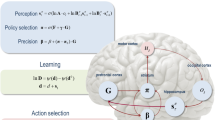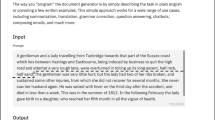Abstract
We are going to explain partial blocking as the result of diachronic processes based on what we will call associative learning. Especially, we argue that the task posed by partial blocking phenomena is to explain their emergence from unambiguous and fully expressive languages. This contrasts with approaches that presuppose underspecified semantic meanings or ineffability like Bidirectional Optimality Theory (Bi–OT) and some game theoretic explanations. We introduce a formal framework based on learning, speaker’s preferences and pure semantics for describing diachronic strengthening of meaning. Moreover, we show how the diachronic development of systems of semantically co–extensive forms can be described in terms of a complete system of diachronic laws.
Similar content being viewed by others
References
Beaver D. (2004). The optimization of discourse. Linguistics and Philosophy 27(1): 3—-56
Beaver D., Lee H. (2004). Input–output mismatches in OT. In: Blutner R., Zeevat H. (eds), Optimality theory and pragmatics. Basingstoke, NY, Palgrave/Macmillan, pp. 112–153
Benz, A. (2001). Towards a framework for bidirectional optimality theory in dynamic contexts. Humboldt Universität Berlin. Available as ROA 465–0901.
Benz A. (2003). On coordinating interpretations – optimality and rational interaction. In: Kühnlein P., Rieser H., Zeevat H. (eds) Perspectives on dialogue in the new millennium. Amsterdam, Philadelphia, John Benjamins, pp. 307–334
Blutner R. (1998). Lexical pragmatics. Journal of Semantics 15, 115–162
Blutner R. (2000). Some aspects of optimality in natural language interpretation. Journal of Semantics 17, 189–216
Blutner R., Jäger G. (2000). Against lexical decomposition in syntax. In: Wyner A.Z. (eds), Proceedings of the fifteenth annual conference, IATL 15. Haifa, University of Haifa, pp. 113–137
Carpenter B. (1992). The logic of typed feature structures. Cambridge, Cambridge University Press
Chomsky N. (1981). Lectures on government and binding: the pisa lectures. Dordrecht, Foris
Dekker P., van Rooij R. (2000). Bi–directional optimality theory: an application of game theory. Journal of Semantics 17, 217–242
Eckardt R. (2001). On the underlying mechanics of certain types of meaning change. Linguistische Berichte 185, 31–74
Grosz B., Joshi A., Weinstein S. (1995). Centering: a framework for modeling the local coherence of discourse. Computational Linguistics 21(2): 203–226
Hendriks P., de Hoop H. (2001). Optimality theoretic semantics. Linguistics and Philosophy 24(1): 1–32
Horn L. (1984). Towards a new taxonomy of pragmatic inference: Q–based and R–based implicature. In: Schiffrin D. (eds), Meaning, Form, and Use in Context: Linguistic Applications. Washington, Georgetown University Press, pp. 11–42
Jäger G. (2002). Some notes on the formal properties of bidirectional optimality theory. Journal of Logic, Language and Information 11(4): 427–451
Levinson S.C. (2000). Presumptive meanings. Cambridge, MA, The MIT Press
Lewis D. (1969). Convention. Cambridge, Harvard University Press
Mattausch J. (2000). On optimization in discourse generation. Master Thesis Amsterdam: Universiteit van Amsterdam
Mattausch J. (2004). Optimal theoretic pragmatics and binding phenomena. In: Blutner R., Zeevat H. (eds), Optimality theory and pragmatics. Basingstoke, Palgrave Macmillan, pp. 63–90
Parikh P. (2001). The use of language. Stanford, CSLI Publications
van Rooij R. (2004). Signalling games select horn strategies. Linguistics and Philosophy 27, 493– 527
Weibull J.W. (1995). Evolutionary game theory. Cambridge, MA, MIT Press
Young H.P. (1998). Individual strategy and social structure. Princeton, New Jersey, Princeton University Press
Zipf G. (1949). Human behavior and the principle of least effort. Cambridge, AddisonWesley
Author information
Authors and Affiliations
Corresponding author
Rights and permissions
About this article
Cite this article
Benz, A. Partial blocking and associative learning. Linguistics & Philosophy 29, 587–615 (2006). https://doi.org/10.1007/s10988-006-9005-3
Received:
Accepted:
Published:
Issue Date:
DOI: https://doi.org/10.1007/s10988-006-9005-3




